Do you wonder, “Are stars visible during a solar eclipse?”
Yes, stars and constellations are visible during a solar eclipse. When the moon briefly obscures the sun’s intense glare, the sky darkens enough to reveal some brighter stars, creating a captivating celestial display.
As someone deeply intrigued by the cosmos, I’ve witnessed several solar eclipses. Each time the moon shields the sun, stars briefly emerge, creating a mesmerizing sight. This personal fascination drives my exploration of this topic, connecting our world with the universe.
There’s something profoundly humbling about standing beneath the darkened sky during a solar eclipse, surrounded by fellow enthusiasts, and feeling an indescribable connection to the universe.
In a Nutshell:
- Stars and constellations are visible during a solar eclipse, enhancing the celestial experience. The concept of stars becoming visible during an eclipse can be attributed to their positions on the celestial sphere, a theoretical sphere with Earth at the center and all celestial objects, including stars and constellations, positioned on its surface.
- Factors like eclipse duration, geographic location, and safety precautions significantly influence star visibility.
- The article dispels common myths about solar eclipses and fosters a deeper appreciation for this captivating astronomical event.
Welcome to the world of solar eclipses, where the sun, moon, and stars create a captivating celestial spectacle. Solar eclipses have fascinated humanity for centuries and remain one of the most captivating astronomical events. During a solar eclipse, the moon briefly shields the sun, casting an unusual twilight.
Amidst the solar eclipse’s awe-inspiring spectacle lies the possibility of glimpsing otherwise invisible stars. Factors like eclipse duration, location, and safety precautions significantly affect this experience.
In this article, you get to
Experience the Phenomenon of Solar Eclipses: Understand the different types of solar eclipses, including total, partial, and annular, and learn about their rarity and unique characteristics.
Dispel Myths and Misconceptions: Explore common misconceptions about solar eclipses, such as their effects on pregnancy, natural disasters, and animal behavior, and gain a scientific understanding of these phenomena.
Witness Stars and Celestial Bodies: Discover how and when stars, planets, and other celestial objects become visible during a solar eclipse, including their enhanced visibility during totality or annularity.
Explore the Twilight Zone Effect: Learn about creating a “twilight zone” during a solar eclipse, where stars and planets can be seen despite the darkened sky, and understand the science behind this phenomenon.
Understand Factors Influencing Star Visibility: Explore the geographical location, weather conditions, and atmospheric factors that influence the visibility of stars during a solar eclipse, enabling you to plan for optimal viewing.
By the end of this article, you’ll have a comprehensive understanding of solar eclipses, be well-informed about the visibility of stars and celestial phenomena during these events, and know how to safely observe them while appreciating their unique beauty and scientific significance.
Let’s dive right in.
Understanding Solar Eclipses

The orbits of celestial bodies also come into play, affecting the alignment of the sun, moon, and stars during an eclipse. A rare and captivating solar eclipse occurs when the moon moves between the sun and the Earth, casting its shadow upon our planet.
Depending on the alignment of the sun, moon, and Earth, we witness three distinct types of solar eclipses:
Total Solar Eclipse: When the moon completely conceals the sun’s disk, leaving only a faint ring of light known as the solar corona – the sun’s outer atmosphere. This awe-inspiring event is visible only from a narrow path on the Earth’s surface, known as the path of totality, where the moon’s shadow falls. The duration of totality varies depending on location and celestial positions but typically lasts for a few fleeting minutes.
Frequency of Total Solar Eclipses: On average, there are about 2 to 5 total solar eclipses each year visible from different parts of the world. Source: NASA
Partial Solar Eclipse: The moon covers only a portion of the sun’s disk, resulting in a crescent-shaped sun. Unlike the total eclipse, you can observe this captivating spectacle from a broader geographical area. However, it lacks the dramatic reveal of the solar corona.
Annular Solar Eclipse: This unique eclipse occurs when the moon is farther away from the Earth, causing it to appear smaller than the sun. Consequently, the moon doesn’t entirely obscure the sun’s disk, creating a brilliant ring of light known as the annulus or “ring of fire.” Like the total eclipse, an annular solar eclipse is visible only along a narrow path on the Earth’s surface, where the moon’s shadow falls.
Visibility Depends on Eclipse Duration: The duration of the total solar eclipse significantly impacts the visibility of stars. Longer eclipses provide more time for observers to see stars and celestial objects. Source: TimeandDate
Related Content: Read my article How Long Do Solar Eclipses Last?
Myths and Misconceptions about Solar Eclipses
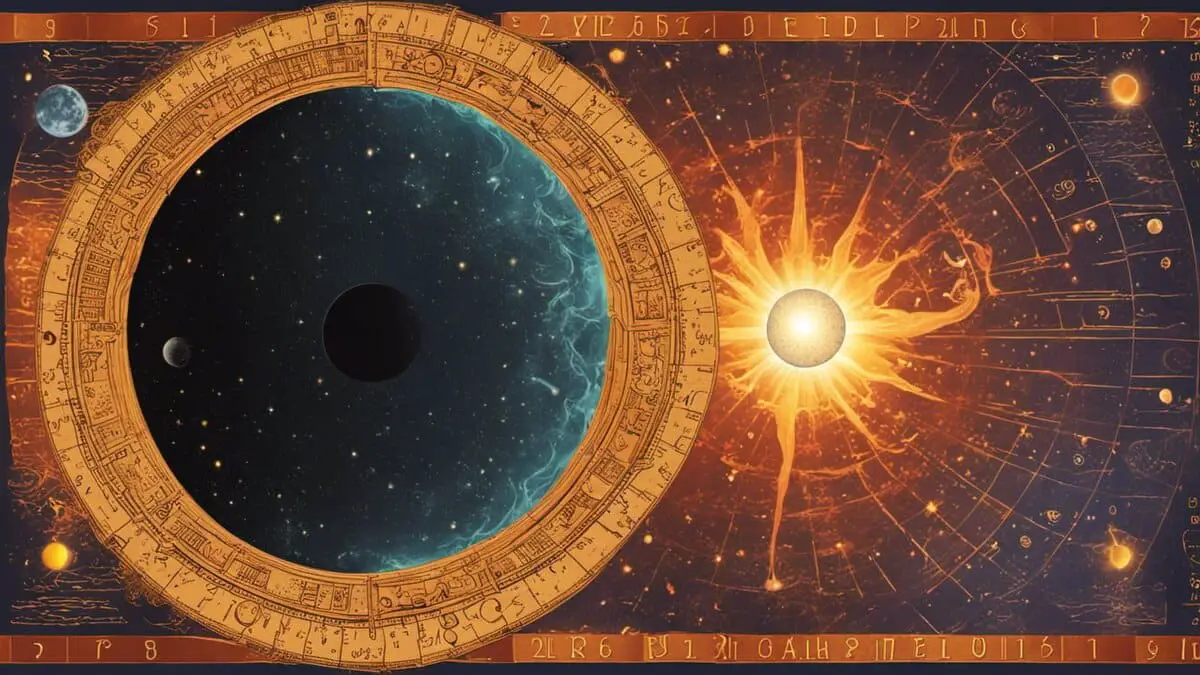
Solar eclipses have captivated and sometimes instilled fear in people. Various cultures have crafted myths and misconceptions surrounding these celestial events.
Here are some of these beliefs, debunked by science:
- Harm to Pregnant Women and Unborn Babies: One common misconception is that solar eclipses harm pregnant women and their unborn children. It’s important to emphasize that no scientific evidence supports this claim. Solar eclipses have no impact on human health or fertility.
- Causing Natural Disasters: Some cultures have associated solar eclipses with natural disasters like earthquakes, volcanic eruptions, or floods. However, scientific research does not validate this belief. Solar eclipses do not influence the Earth’s geology or climate in any way.
- Effect on Animal Behavior: While there is some truth to the idea that solar eclipses can affect animal behavior, it’s essential to clarify. Certain animals may react to the sudden changes in light and temperature during an eclipse. For instance, birds may stop singing or roosting, insects may become more active or quiet, and mammals may seek shelter or become restless. These responses are temporary and do not harm the animals.
While solar eclipses are not inherently dangerous, observing them without proper precautions can harm human vision. Later in this article, we will explore how to view a solar eclipse safely.
The Phenomenon of Solar Eclipse
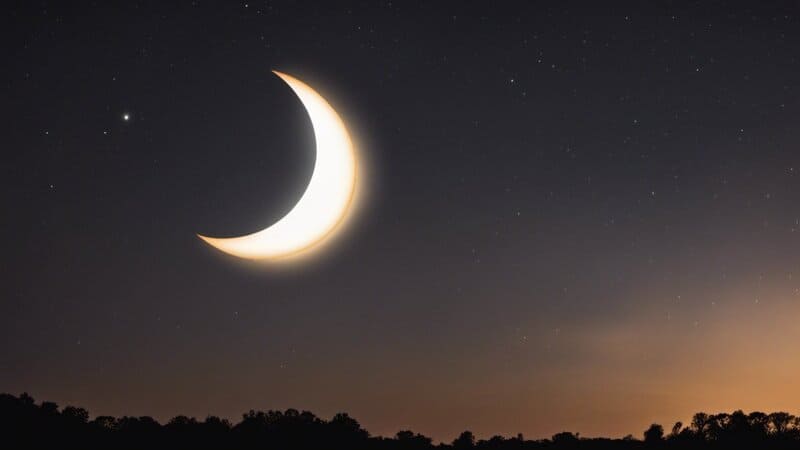
What Happens During a Solar Eclipse?
In my experience, the most captivating aspect of a solar eclipse is the transformation of the sky from a bright day to an otherworldly twilight.
During a solar eclipse, the moon obstructs varying degrees of the sun’s light from reaching Earth, resulting in a striking transformation of the sky and surroundings.
Depending on your location and the type of solar eclipse you’re witnessing, you may encounter some or all of these effects:
- Gradual Darkening of the Sky: The sky darkens as the moon progressively covers the sun’s disk. It’s important to note that this darkness isn’t absolute, as some residual light filters through from beyond the moon’s shadow.
- Temperature Drop: With less sunlight reaching the Earth, there’s a noticeable or subtle decrease in temperature. The extent of this drop depends on your location and prevailing weather conditions.
- Wind Shifts: Changes in wind direction or speed may occur due to alterations in air pressure caused by the temperature variations between areas within and outside of the moon’s shadow.
- Altered Colors: Objects may exhibit subdued or distorted colors as the reduced light affects your eyes’ perception.
- Sharper or Softer Shadows: With fewer available light sources, you’ll observe sharper or softer shadows cast by objects.
- Shadow Bands or Snake Bands: On flat surfaces like walls or floors, peculiar patterns of light and dark, known as shadow bands or snake bands, may appear. These intriguing phenomena arise from the interference of light waves as they pass through the atmosphere.
Experiencing these effects during a solar eclipse can add to the wonder and intrigue of this celestial event.
Stages of a Solar Eclipse

A solar eclipse unfolds in several captivating stages, spanning two or more hours, offering a continually evolving spectacle:
First Contact
At this juncture, the moon makes its initial contact with the sun’s edge, approaching it from the right (as seen from the Northern Hemisphere). Previously hidden in the daytime sky, the moon emerges as a black disc, gradually blocking the sun.
Partial Eclipse
Following the first contact, the moon covers a segment of the sun’s disk, giving rise to a crescent-shaped sun. This partial eclipse endures approximately an hour before and after the total or annular phase.
Second Contact
As the moon completely obscures the sun’s disk, the phase of totality or annularity begins. Along the moon’s leading edge, the last vestiges of sunlight penetrate lunar valleys, forming a sequence of bright dots known as Baily’s beads.
Just before the moon completely shrouds the sun, a brilliant final flash, coupled with a glimpse of the corona, creates a stunning effect called the diamond ring.
Following the disappearance of the diamond ring, you may observe a slender band of red light encircling the moon’s edge – this is the chromosphere, part of the sun’s lower atmosphere.
Totality or Annularity
This represents the stage when the sun is entirely concealed by the moon, unveiling the full splendor of the solar corona or the luminous ring of light surrounding it. This solar eclipse phase is the most breathtaking, affording a view of sun features typically invisible to the naked eye.
The corona manifests as an ethereal, irregular halo of light that extends far beyond the sun’s disk, displaying various shapes and colors contingent on the sun’s magnetic activity and orientation.
The annulus, or ring of fire, presents a radiant, uniform circle of light against the darkened sky. Totality or annularity persists for a few minutes, contingent on your location and the relative positions of the sun and moon.
From my perspective, the brief moments of totality or annularity during a solar eclipse are like a cosmic curtain being drawn, revealing stars and planets in all their glory.
Third Contact
This marks when the moon unveils the sun’s disk again, signifying the conclusion of totality or annularity. The same phenomena observed during the second contact occur in reverse order: chromosphere, diamond ring, and Baily’s beads.
Partial Eclipse (Again)
After totality or annularity, the moon continues to cover a portion of the sun’s disk, forming a crescent-shaped sun. This partial eclipse extends for about an hour.
Fourth Contact
The eclipse concludes as the moon departs from the sun’s edge. The moon recedes into obscurity in the daytime sky, and the sun resumes its customary appearance.
And with that, the eclipse is finished, leaving you with a lasting memory of the celestial spectacle you’ve witnessed.
Visibility of Stars During a Solar Eclipse
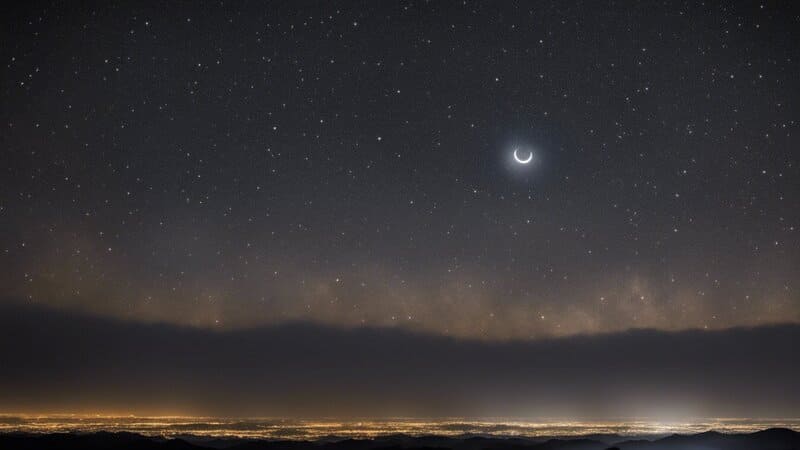
Are Stars Visible During A Solar Eclipse?
Yes, stars can be observed during a solar eclipse, but only during the phases of totality or annularity. At these stages of a solar eclipse, when the sun is entirely obscured by the moon, stars, and planets not typically visible in the daytime sky make a special appearance.
This phenomenon occurs because the sky becomes dark enough during totality or annularity to permit the fainter light from these celestial bodies to reach your eyes. While stars and planets take center stage during an eclipse, it’s important to remember that our galaxy, the Milky Way, is an intricate part of this cosmic panorama.
It’s important to note that the darkness across the sky during these phases is not uniform. Some residual light emanates from beyond the moon’s shadow. Consequently, stars and planets will be more pronounced and visible closer to the eclipsed sun than the horizon.
Why It Is Possible to See Stars During a Solar Eclipse
Stars become visible during a solar eclipse due to the dynamic interplay of various celestial and atmospheric light sources.
Here’s why it happens:
- Multiple Sources of Light: The sun does not solely illuminate the sky. Other celestial sources, including the moon, planets, stars, and the atmosphere, contribute to the ambient light.
- Reflection and Emission of Light: The moon reflects some of the sun’s light to Earth, creating moonlight. Similarly, planets reflect sunlight, forming planetshine. Stars, on the other hand, emit their light, generating starlight. The atmosphere scatters sunlight in various directions, resulting in daylight.
- Altering Light Dynamics During an Eclipse: A solar eclipse changes the distribution of light sources. The moon obstructs some or all of the sun’s light from reaching Earth, diminishing daylight. It also blocks some or all of its reflected sunlight, reducing moonlight. Similarly, planets can experience diminished planetshine during an eclipse.
- Starlight Enhancement: Crucially, no external objects can obstruct stars during an eclipse. Therefore, the light emitted by stars remains unaffected and becomes more pronounced. The atmosphere also scatters starlight and the planetshine in various directions, contributing to twilight.
During a solar eclipse, this shifting balance among light sources, favoring starlight and twilight, allows stars and planets to become more visible than usual.
However, the visibility depends on additional factors, such as your geographic location, prevailing weather conditions, and the specific type and duration of the eclipse you’re witnessing.
The Twilight Zone
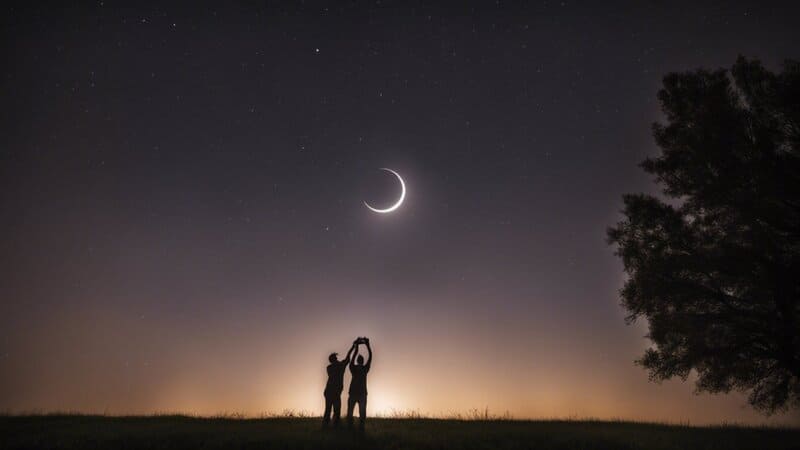
Perception of Stars During Eclipse’s “Twilight Zone”
While stars appearing during a solar eclipse is well-known, digging deeper uncovers intriguing details. Exploring factors like light sources and the unique ‘twilight zone’ phenomenon sheds fresh light on solar eclipses. It’s a testament to evolving astronomy and our quest to understand the universe.
The twilight zone’s existence is a result of both the curvature of the Earth and the moon’s shadow. Unlike a perfect cone, the moon’s shadow takes on a tapered cylinder shape that widens as it extends away from the moon. Consequently, the edge of the moon’s shadow doesn’t touch the Earth at a single point but traces a curved line across the planet’s surface, known as the “limb of the moon’s shadow.”
This limb of the moon’s shadow is the line between totality or annularity and partiality. The moon entirely conceals the sun inside this boundary, and the sky becomes sufficiently dark to unveil stars and planets near the eclipsed sun. Beyond this boundary, the sun remains partially visible, and the sky remains too bright for star and planet observation near the sun.
However, an intriguing transition zone exists between these two regions. In this transition zone, the moon partly obscures the sun, yet not enough to induce complete darkness. This zone is aptly named the “twilight zone” and extends approximately 100 kilometers on either side of the limb of the moon’s shadow. Within this zone, you can simultaneously witness the sun and certain stars and planets, creating a unique celestial spectacle.
How The Twilight Zone Enhances Star Visibility
The twilight zone enhances star visibility in two intriguing ways: by reducing daylight and by creating striking contrast.
Reducing Daylight: In the twilight zone, daylight diminishes, lowering the sky’s brightness. This reduction in light makes it notably easier to discern fainter objects, including stars and planets. The extent of daylight reduction varies depending on your proximity to the limb of the moon’s shadow. The closer you are to this boundary, the more daylight recedes, and vice versa.
Creating Contrast: The twilight zone ingeniously sets the stage for stars and planets to emerge prominently against the backdrop of the sky. This striking contrast arises from the disparity of brightness between the eclipsed sun and the surrounding sky. The eclipsed sun serves as a brilliant point source of light, effectively illuminating nearby stars and planets, causing them to appear brighter than the rest of the sky.
The twilight zone offers a unique and captivating opportunity to observe stars and planets during a solar eclipse. Capturing the image of stars during an eclipse can be a rewarding endeavor for amateur astronomers and astrophotography enthusiasts. Here, these celestial objects are visible and enhanced by the eclipse phenomenon, resulting in an exceptional celestial spectacle.
Related Content: Read my article Can I take a photo of a solar eclipse?
Other Celestial Bodies to Look For
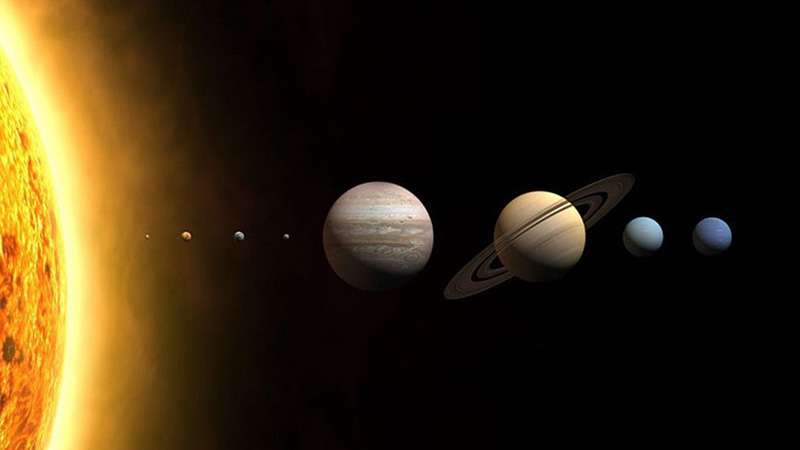
The Visibility of Planets During a Solar Eclipse
Beyond stars, you can observe certain planets during a solar eclipse, particularly during totality or annularity. The moon’s path during a solar eclipse follows an imaginary line called the ecliptic, which is the sun’s apparent path across the sky over a year. The planets you can see depend on their positioning relative to the sun and Earth during the eclipse.
Inferior Planets: These are planets closer to the sun than Earth, comprising Mercury and Venus. Inferior planets become visible during a solar eclipse when they are in conjunction with the sun, signifying alignment with the sun and Earth.
In this scenario, they appear as tiny black dots crossing the sun’s face, creating a rare spectacle known as a “transit.” Transits of Mercury occur approximately 13 times per century, while Venus takes place roughly twice per century.
Superior Planets: These planets are situated farther from the sun than Earth and encompass Mars, Jupiter, Saturn, Uranus, Neptune, and Pluto. You can view superior planets during a solar eclipse when they oppose the sun, meaning they are on the opposite side of Earth from the sun.
In this arrangement, they manifest as bright stars near the eclipsed sun, reaching their peak brightness and proximity to Earth. The frequency of oppositions for superior planets varies based on each planet’s orbital period.
This unique opportunity to witness planets during a solar eclipse adds an extra layer of celestial wonder to the eclipse experience.
Other Observable Phenomena During an Eclipse
In addition to stars and planets, a solar eclipse unveils a host of captivating phenomena:
- The Solar Corona: Normally hidden by the sun’s intense glare, the solar corona is the sun’s outer atmosphere. During totality or annularity, you can witness the corona as a delicate, irregular halo of light enveloping the eclipsed sun. The corona’s shape and hues vary based on the sun’s magnetic activity and orientation.
- The Chromosphere: This segment of the sun’s lower atmosphere, also typically concealed by the sun’s brilliance, comes into view during second and third contact. It manifests as a slender red light encircling the moon’s edge. Notably, the chromosphere is the site of many sun flares and prominences.
- Baily’s Beads: At second and third contact, bright dots of light emerge along the moon’s leading and trailing edges. These beads result from the last rays of light passing through lunar valleys, forming a luminous chain.
- The Diamond Ring: A breathtaking spectacle unfolds in the moments just before and after totality or annularity. It’s marked by a final, brilliant flash of light and an emerging view of the corona, creating a mesmerizing diamond ring effect.
- Shadow Bands or Snake Bands: Unusual patterns of light and dark materialize on flat surfaces like walls or floors during totality or annularity. These bands are the outcome of light wave interference within Earth’s atmosphere.
These additional phenomena contribute to a solar eclipse’s enchantment and scientific intrigue, making it an extraordinary celestial event to witness.
Factors That Influence Star Visibility During an Eclipse
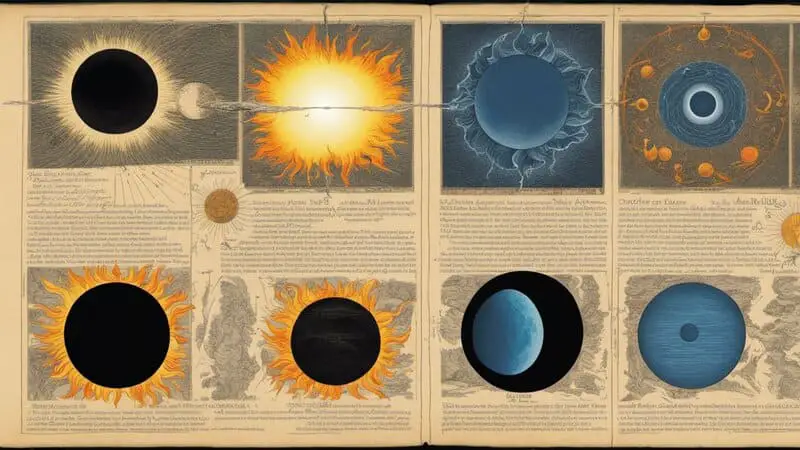
Geographical Location and Star Visibility
Your geographical location plays a pivotal role in determining your ability to observe stars during a solar eclipse, primarily through two key factors:
Distance from the Path
Your proximity to the path of totality or annularity dictates the extent of the sun’s coverage by the moon and the resulting darkness of the sky. Closeness to the path equates to more comprehensive sun coverage and a darker sky, while greater distance leads to less sun coverage and a brighter sky.
Consequently, for optimal star visibility during a solar eclipse, it’s essential to be near the path, experiencing either totality or annularity or, at the very least, a significant degree of partiality.
Local Time Zone
Your location within a specific time zone influences when the solar eclipse occurs in your area and the sun’s elevation in the sky. A higher sun position correlates with a brighter sky, making it more challenging to spot stars. Conversely, a lower sun position produces a dimmer sky, facilitating star observation.
To enhance your chances of seeing stars during a solar eclipse, aim to be in a time zone where the eclipse coincides with the sun being low on the horizon, such as near sunrise or sunset.
Considering these geographical factors, you can strategically position yourself to enjoy the celestial spectacle of stars during a solar eclipse.
Weather and Atmospheric Conditions
Drawing from years of firsthand eclipse experiences worldwide, I’ve gained insights into optimizing star visibility. The visibility of stars during a solar eclipse is notably influenced by your local weather and atmospheric conditions, impacting both your view of the sun and moon and your view of stars and planets.
Here’s how these factors interplay:
- Clear or Cloudy Skies: The clarity of your sky, whether clear or cloudy, directly affects your ability to see the sun and moon clearly during a solar eclipse. A clear sky permits an unobstructed view of both celestial bodies, allowing you to observe all stages of the eclipse. Conversely, a cloudy sky may obscure your view, preventing you from seeing the sun and moon entirely or only partially. In such cases, you might miss some or all eclipse phases. Hence, clear skies are necessary for star observation during a solar eclipse to enable unimpeded views of the sun and moon.
- Transparent or Hazy Atmosphere: Your atmosphere’s transparency is paramount when spotting stars and planets. A transparent atmosphere permits clear views of these celestial objects, even if they are faint or positioned near the horizon. However, a hazy atmosphere can obscure stars and planets, rendering them invisible or barely discernible. Haziness might result from dust, smoke, pollution, or moisture. Consequently, to ensure the visibility of stars during a solar eclipse, you require a transparent atmosphere, allowing stars and planets to shine through.
Considering these weather and atmospheric conditions, you can maximize your chances of enjoying the spectacular sight of stars during a solar eclipse.
Observing a Solar Eclipse Safely
Protective Measures for Observing a Solar Eclipse
Observing a solar eclipse is an incredible experience, but it can also pose risks to your eyes if not done safely. When viewed directly, the sun emits powerful radiation that can cause permanent or temporary eye damage.
To ensure a safe and enjoyable eclipse observation, here are crucial protective measures to follow:
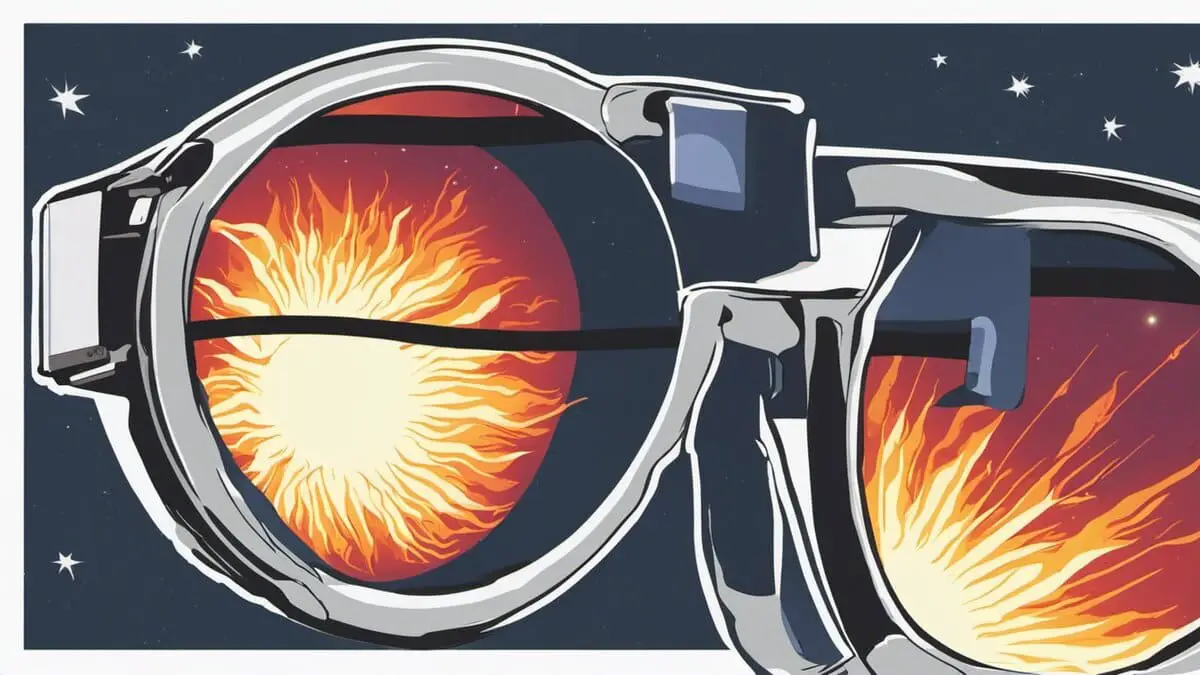
- Use Proper Solar Filters or Eclipse Glasses: Employ specialized solar filters or eclipse glasses for safe solar viewing. These devices effectively block most of the sun’s harmful rays, allowing you to observe the sun without risking eye damage. Avoid using regular sunglasses, binoculars, telescopes, cameras, or any other equipment not intended for solar viewing, as they can magnify the sun’s radiation, putting your eyes at risk.
- Opt for the Projection Method: Consider indirect viewing through the projection method. This technique involves projecting the sun’s image onto a screen, wall, or surface using a pinhole camera, cardboard box, or mirror. By doing so, you can observe the sun’s shape and changes without the need to gaze directly at it.
- Leverage Online Resources or Live Streams: Explore watching the solar eclipse virtually through online resources and live streams. Numerous websites, apps, and organizations like NASA, ESA, and TimeandDate provide live coverage and valuable information about solar eclipses. You can also access videos and images from past eclipses to deepen your understanding of these celestial events.
Remember that direct viewing of the sun without protection is only safe during totality or annularity when the moon entirely conceals the sun. However, avoid missing the second and third contact phases when the sun reemerges and becomes potentially harmful. Prioritizing eye safety ensures you can enjoy the eclipse without compromising your vision.
The Risk of Vision Damage During a Solar Eclipse
The risk of vision damage during a solar eclipse is real and severe. Looking at a solar eclipse without protection is genuinely hazardous to your eyes due to the sun’s powerful ultraviolet (UV) radiation.
- Solar Retinopathy: UV radiation can burn your retina, leading to solar retinopathy, which might cause blurred vision, blind spots, distorted colors, or permanent blindness.
- Delayed Symptoms: Symptoms may not appear immediately but could emerge hours or days later.
- No Cure: Unfortunately, solar retinopathy has no remedy, and recovery depends on damage severity and individual response.
- Heightened Risk During Eclipse: Curiosity and the eclipse’s dimmer appearance increase the risk of eye damage.
- Curiosity: People may want to view the eclipse without protection due to its rarity and spectacle.
- Contrast: During the eclipse, the sun seems less bright, potentially leading to a false sense of safety.
Protective Measures:
- Use proper solar filters or eclipse glasses: Specially designed devices block most harmful rays, ensuring safe viewing.
- Projection method: Indirect viewing, such as pinhole cameras, lets you see the eclipse without direct exposure.
- Online Resources and Live Streams: Explore virtual options for safe eclipse observation.
Critical Reminder
The only safe time to view the sun without protection is during totality or annularity when the moon entirely hides the sun.
The succeeding eclipse phases require proper solar filters or glasses to protect your eyes. Take advantage of the second and third contact phases when the sun becomes dangerous again. Your eye safety is paramount for an enjoyable eclipse experience.
Read about how to craft your own DIY Solar Filter.
The Next Opportunities for Observing a Solar Eclipse
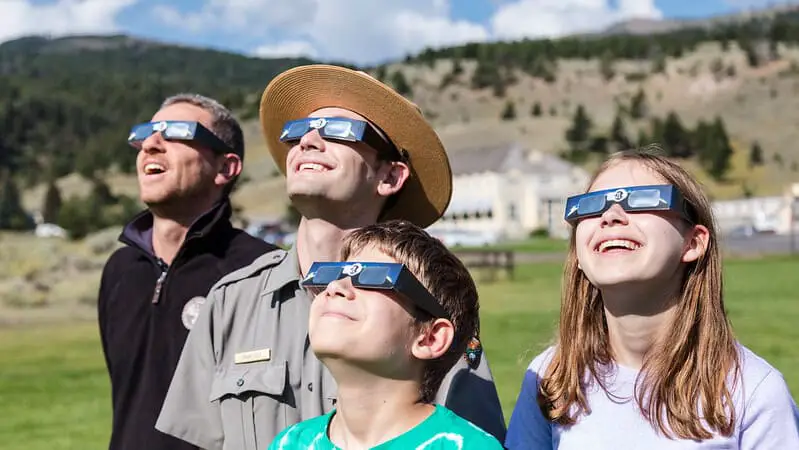
If you’re keen on observing stars during a solar eclipse, you might wonder when your next chance will arise. The availability of these opportunities varies by location, offering different possibilities of witnessing total, partial, or annular solar eclipses. Keep an eye on the calendar for solar eclipses throughout the year, and plan your astronomical adventures accordingly.
Upcoming Solar Eclipses (According to TimeandDate):
- April 20th, 2024: A total solar eclipse was visible from North America (central, east), South America (south), Europe (northwest), and Africa (northwest).
- August 12th, 2026: A total solar eclipse is visible from Europe, Asia, Africa, North America (north), South America (south), and the Atlantic Ocean.
- August 2nd, 2027: A total solar eclipse is visible from Africa, Europe, Asia, and the Indian Ocean.
- July 22nd, 2028: A total solar eclipse is visible from Australia, New Zealand, South America (south), and the Pacific Ocean.
To discover more about solar eclipses specific to your location, you can utilize online tools such as TimeandDate or NASA. These resources provide dates, times, eclipse types, and magnitudes.
You can also employ tools like Stellarium or SkySafari to simulate the sky during these eclipses, allowing you to anticipate which stars and planets will be visible.
Summary: Can You See Stars during A Solar Eclipse
Thank you for reading my article “Are Stars Visible During a Solar Eclipse?”
In the vast cosmos, each star is a physical object with unique characteristics, some of which become visible in the darkened sky during a solar eclipse. Experiencing stars during a solar eclipse is exceptional, underscoring whether stars are visible during a solar eclipse. This extraordinary event transcends standard stargazing, forging a profound connection between astronomy and our world.
When a solar eclipse unfolds, stars and planets, typically hidden behind the sun’s brilliance, come into view, offering a vivid display of the diverse celestial realm. This celestial occurrence firmly establishes that stars are visible during a solar eclipse.
Moreover, the eclipse grants firsthand insight into the cosmic forces at play, shedding light on the fundamental physics of this captivating phenomenon. As the surroundings undergo rapid shifts in illumination and temperature, the experience becomes a sensory journey worth sharing with fellow enthusiasts.
Beyond scientific exploration, observing stars during a solar eclipse serves as a conduit to connect with history and culture. It forges a link between past and present observers, enabling a deeper understanding of their amazement and interpretations. Additionally, it provides a platform to explore the rich tapestry of myths and legends inspired by solar eclipses, unraveling their profound significance and lasting resonance.
Embracing this extraordinary encounter reaffirms the visibility of stars during a solar eclipse and embarks on a voyage of profound appreciation for the cosmos, the continuous thread of human history, and the natural world enveloping us.
Interested in more Solar Eclipse articles?




